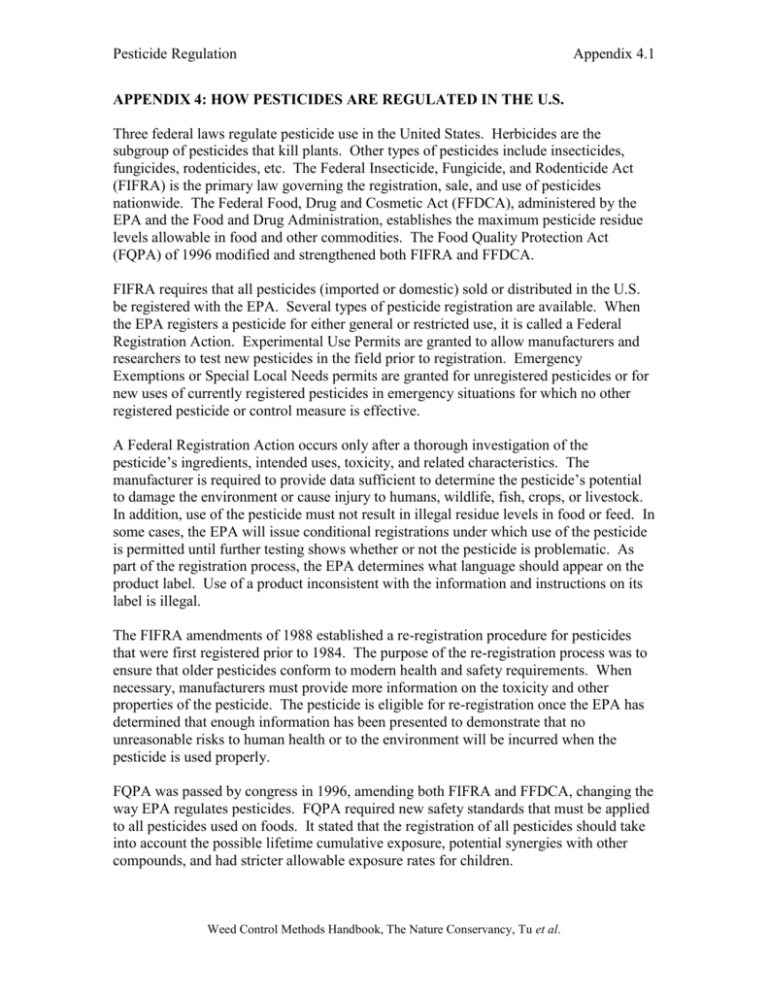How pesticides are regulated
advertisement

Pesticide Regulation Appendix 4.1 APPENDIX 4: HOW PESTICIDES ARE REGULATED IN THE U.S. Three federal laws regulate pesticide use in the United States. Herbicides are the subgroup of pesticides that kill plants. Other types of pesticides include insecticides, fungicides, rodenticides, etc. The Federal Insecticide, Fungicide, and Rodenticide Act (FIFRA) is the primary law governing the registration, sale, and use of pesticides nationwide. The Federal Food, Drug and Cosmetic Act (FFDCA), administered by the EPA and the Food and Drug Administration, establishes the maximum pesticide residue levels allowable in food and other commodities. The Food Quality Protection Act (FQPA) of 1996 modified and strengthened both FIFRA and FFDCA. FIFRA requires that all pesticides (imported or domestic) sold or distributed in the U.S. be registered with the EPA. Several types of pesticide registration are available. When the EPA registers a pesticide for either general or restricted use, it is called a Federal Registration Action. Experimental Use Permits are granted to allow manufacturers and researchers to test new pesticides in the field prior to registration. Emergency Exemptions or Special Local Needs permits are granted for unregistered pesticides or for new uses of currently registered pesticides in emergency situations for which no other registered pesticide or control measure is effective. A Federal Registration Action occurs only after a thorough investigation of the pesticide’s ingredients, intended uses, toxicity, and related characteristics. The manufacturer is required to provide data sufficient to determine the pesticide’s potential to damage the environment or cause injury to humans, wildlife, fish, crops, or livestock. In addition, use of the pesticide must not result in illegal residue levels in food or feed. In some cases, the EPA will issue conditional registrations under which use of the pesticide is permitted until further testing shows whether or not the pesticide is problematic. As part of the registration process, the EPA determines what language should appear on the product label. Use of a product inconsistent with the information and instructions on its label is illegal. The FIFRA amendments of 1988 established a re-registration procedure for pesticides that were first registered prior to 1984. The purpose of the re-registration process was to ensure that older pesticides conform to modern health and safety requirements. When necessary, manufacturers must provide more information on the toxicity and other properties of the pesticide. The pesticide is eligible for re-registration once the EPA has determined that enough information has been presented to demonstrate that no unreasonable risks to human health or to the environment will be incurred when the pesticide is used properly. FQPA was passed by congress in 1996, amending both FIFRA and FFDCA, changing the way EPA regulates pesticides. FQPA required new safety standards that must be applied to all pesticides used on foods. It stated that the registration of all pesticides should take into account the possible lifetime cumulative exposure, potential synergies with other compounds, and had stricter allowable exposure rates for children. Weed Control Methods Handbook, The Nature Conservancy, Tu et al. Pesticide Regulation Appendix 4.2 Although the EPA oversees pesticide registration, individual states now have the primary enforcement responsibility, termed “state primacy”. Each state must demonstrate that their regulatory mechanisms equal or exceed those of the EPA. States that do not properly enforce federal requirements in a timely manner can lose their enforcement authority. States may also require that pesticides be registered under their own systems, before the pesticide may be used in that state (for example, California requires this). Date Authored: April 2001 Weed Control Methods Handbook, The Nature Conservancy, Tu et al.









